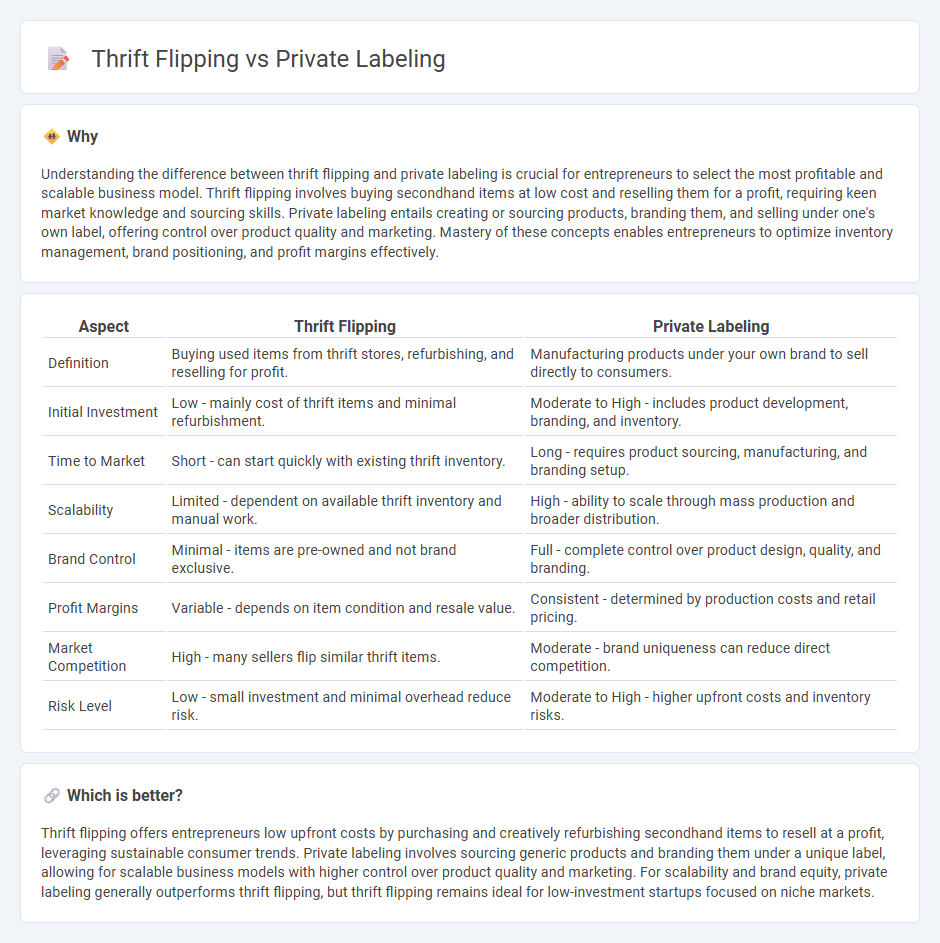
Thrift flipping involves purchasing secondhand items and creatively refurbishing them for resale, offering a low-cost entry point into entrepreneurship with minimal upfront investment. Private labeling requires sourcing generic products from manufacturers, then branding and marketing them under your own label, allowing greater control over product quality and brand identity. Explore the advantages and challenges of thrift flipping versus private labeling to determine which strategy aligns best with your entrepreneurial goals.
Why it is important
Understanding the difference between thrift flipping and private labeling is crucial for entrepreneurs to select the most profitable and scalable business model. Thrift flipping involves buying secondhand items at low cost and reselling them for a profit, requiring keen market knowledge and sourcing skills. Private labeling entails creating or sourcing products, branding them, and selling under one's own label, offering control over product quality and marketing. Mastery of these concepts enables entrepreneurs to optimize inventory management, brand positioning, and profit margins effectively.
Comparison Table
| Aspect | Thrift Flipping | Private Labeling |
|---|---|---|
| Definition | Buying used items from thrift stores, refurbishing, and reselling for profit. | Manufacturing products under your own brand to sell directly to consumers. |
| Initial Investment | Low - mainly cost of thrift items and minimal refurbishment. | Moderate to High - includes product development, branding, and inventory. |
| Time to Market | Short - can start quickly with existing thrift inventory. | Long - requires product sourcing, manufacturing, and branding setup. |
| Scalability | Limited - dependent on available thrift inventory and manual work. | High - ability to scale through mass production and broader distribution. |
| Brand Control | Minimal - items are pre-owned and not brand exclusive. | Full - complete control over product design, quality, and branding. |
| Profit Margins | Variable - depends on item condition and resale value. | Consistent - determined by production costs and retail pricing. |
| Market Competition | High - many sellers flip similar thrift items. | Moderate - brand uniqueness can reduce direct competition. |
| Risk Level | Low - small investment and minimal overhead reduce risk. | Moderate to High - higher upfront costs and inventory risks. |
Which is better?
Thrift flipping offers entrepreneurs low upfront costs by purchasing and creatively refurbishing secondhand items to resell at a profit, leveraging sustainable consumer trends. Private labeling involves sourcing generic products and branding them under a unique label, allowing for scalable business models with higher control over product quality and marketing. For scalability and brand equity, private labeling generally outperforms thrift flipping, but thrift flipping remains ideal for low-investment startups focused on niche markets.
Connection
Thrift flipping and private labeling are connected through their shared focus on product sourcing and resale for profit, emphasizing creativity and market differentiation. Thrift flipping involves purchasing secondhand or undervalued items, improving or customizing them, and reselling at a higher price, while private labeling entails sourcing generic products, branding them uniquely, and selling under one's own label. Both strategies leverage supply chain efficiency and branding to maximize entrepreneurial margins and tap into niche markets.
Key Terms
Branding
Private labeling involves creating branded products sold under a retailer's name, enhancing brand identity and customer loyalty through unique packaging and consistent quality. Thrift flipping focuses on sourcing secondhand items, refurbishing them, and reselling with a personal style, but it offers limited opportunity for building distinct brand recognition. Explore deeper insights into how branding strategies impact long-term business growth.
Inventory sourcing
Private labeling sources inventory primarily from manufacturers or wholesalers, allowing businesses to customize products under their own brand for consistent quality control and scalability. Thrift flipping relies on sourcing unique, low-cost items from thrift stores or secondhand markets, focusing on product restoration or creative modifications to increase resale value. Explore detailed strategies and best practices for inventory sourcing in private labeling and thrift flipping to optimize your business model.
Profit margin
Private labeling offers higher profit margins by allowing sellers to source products directly from manufacturers and brand them exclusively, reducing competition and enhancing pricing control. Thrift flipping relies on purchasing undervalued secondhand items and reselling them at a markup, often with lower upfront costs but more variable margins due to sourcing inconsistencies. Explore deeper insights on maximizing profit margins through strategic private labeling and thrift flipping approaches.
Source and External Links
What Is a Private Label? How Private Labels Work in 2025 - Shopify - Private labeling is a business model where a product is manufactured by a third party but branded, marketed, and sold by another company under that company's brand name, often with unique product specifications to differentiate it from competitors.
Private Labeling vs. White Labeling: What's the Difference? - Indeed - Private labeling allows retailers to sell exclusive products customized and controlled by them, giving advantages like better pricing, reduced direct competition, and improved brand loyalty compared to more generic white-label products.
Private label - Wikipedia - A private label is a brand owned by a company that offers products produced either by third parties or its own facilities exclusively under its own brand, distinct from white-label products by the degree of customization and exclusivity.
 dowidth.com
dowidth.com